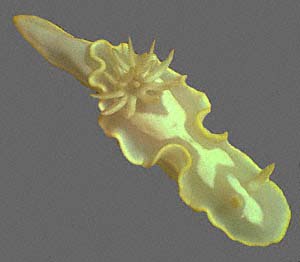
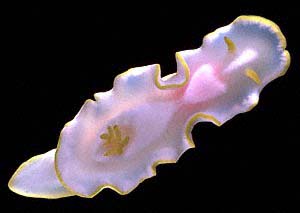
Glossodoris pallida
(Ruppell & Leuckart, 1828)
Order: NUDIBRANCHIA
Suborder: DORIDINA
Family: Chromodorididae
DISTRIBUTION
Tropical Indo-West Pacific.
PHOTO
UPPER: 27mm long alive, Mbudya Is., Dar es Salaam, Tanzania, November, 1976.
LOWER: 32mm long alive, Heron Is., Queensland, August 1985.
PHOTOS: Bill Rudman.
Glossodoris pallida is one of a large number of chromodorids which have a white mantle and yellow or orange border. For convenience I have collectively named them the Chromodoris aureomarginata colour group although this is not meant to signify a close phylogenetic relationship between members of the group. Glossodoris pallida is characterised by the opaque white marks on the mantle.
References:
• Rudman, W.B. (1984) The Chromodorididae (Opisthobranchia: Mollusca) of the Indo-West Pacific: a review of the genera. Zoological Journal of the Linnean Society, 81: 115-273.
• Rudman, W.B. (1985) The Chromodorididae (Opisthobranchia: Mollusca) of the Indo-West Pacific: Chromodoris aureomarginata, C. verrieri and C. fidelis colour groups. Zoological Journal of the Linnean Society, 83: 241-299.
• Rudman, W.B. (1986a) The Chromodorididae (Opisthobranchia: Mollusca) of the Indo-West Pacific: The genus Glossodoris Ehrenberg (=Casella, H. & A. Adams). Zoological Journal of the Linnean Society, 86(2): 101-184.
• Rudman, W.B. (1990b) The Chromodorididae (Opisthobranchia: Mollusca) of the Indo-West Pacific: further species of Glossodoris, Thorunna and the Chromodoris aureomarginata colour group. Zoological Journal of the Linnean Society, 100(3): 263-326.
• Hamatani, I. (1995). Two species of Chromodorididae (Nudibranchia), one newly recorded and one newly established, from Middle Japan. Venus, the Japanese Journal of Malacology, 54(2): 101-107
Rudman, W.B., 1999 (February 23) Glossodoris pallida (Ruppell & Leuckart, 1828). [In] Sea Slug Forum. Australian Museum, Sydney. Available from http://www.seaslugforum.net/find/glospall
Related messages
Re: Glossodoris pallida from Singapore?
September 5, 2007
From: Toh Chay Hoon
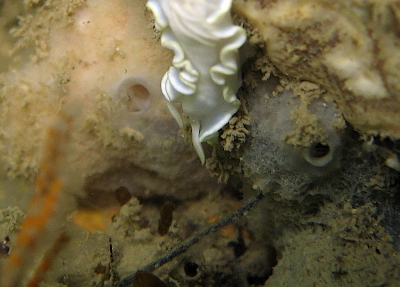
Concerning message #20576:
Dear Dr Bill,
Thanks for the ID.
Here's is a photo of the nudibranch on the greyish sponges. Hope it helps.
Locality: Pulau Hantu, 12m, Singapore, South China Sea, 26 August 2007. Photographer: Toh Chay Hoon.
Best Regards,
Chay Hoon
sonnenflower@gmail.com
Toh Chay Hoon, 2007 (Sep 5) Re: Glossodoris pallida from Singapore?. [Message in] Sea Slug Forum. Australian Museum, Sydney. Available from http://www.seaslugforum.net/find/20638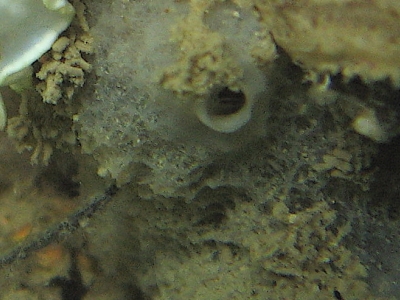
Dear Chay Hoon,
Thanks for your quick reply - and thanks for the sponge photo. It is very valuable. A you can see in these photos the sponge in fact changes colour from white to gray. This type of sponge has usually been identified as 'Spongia sp' because like the Mediterranean 'bath sponge' which gave the genus its name, it lacks spicules in its skeleton and is relatively soft and flexible. But over the last 40 years, Pat Bergquist and other sponge taxonomists have shown that their are two quite distinct families of sponges which superficially look alike, but differ in their metabolite chemistry and in the arrangement of their skeletal fibres. Why this is relevant to nudibranch biologists is that some chromodorids feed specifically on sponges of one of these families - the Thorectidae - but not the other - the Spongiidae. Because their food has often been misidentified as 'Spongia', there is a confusing mix of sponge species recorded in their diet. This confusion has also obscured the fact that spongiids and thorectids metabolise quite different defensive molecules.
Best wishes,
Bill Rudman
Another Glossodoris pallida from Tofo, Mozambique
September 4, 2007
From: Natasja Vandeperre
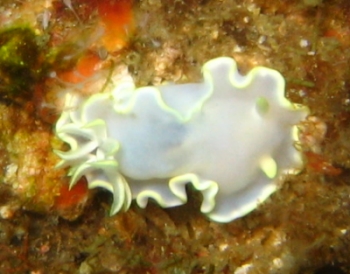
Hello Bill,
Here is another picture of Glossodoris pallida from Mozambique.
Locality: Tofo, Mozambique, Indian Ocean, 22 July 2007. Length: 10 mm. Photographer: Natasja Vandeperre.
Greetings,
Natasja
postmaster@naaktslakken.be
Natasja Vandeperre, 2007 (Sep 4) Another Glossodoris pallida from Tofo, Mozambique. [Message in] Sea Slug Forum. Australian Museum, Sydney. Available from http://www.seaslugforum.net/find/20581Dear Natasja,
Unfortunately not all white chromdorids with a yellow border are Glossodoris pallida. That is why I was hesitant to identify one of your earlier animals as G. pallida [see #20494]. Often the only sure way to separate them is to dissect them and look at their anatomy - not much use if you only have a photo or are undertaking an ecological study which requires the animals to be left alive. I will tentatively leave this animal with G. pallida but it could well be something else.
Best wishes,
Bill Rudman
Glossodoris pallida from Singapore?
September 4, 2007
From: Toh Chay Hoon
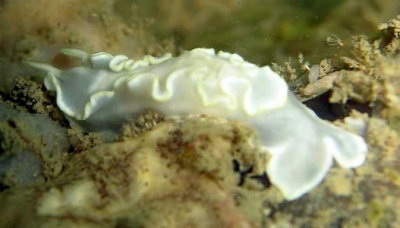
Dear Dr Bill,
I found this nudibranch during a dive at Pulau Hantu, one of the southern islands of Singapore. It was found on some greyish sponges in a vertical position. A check on the forum, the nearest that I could get is Glossodoris pallida. Please advise.
Locality: Pulau Hantu, 12m, Singapore, South China Sea, 26 August 2007, Greyish sponges on rubbles. Length: 30mm. Photographer: Toh Chay Hoon.
Thank you.
Toh Chay Hoon
sonnenflower@gmail.com
Toh Chay Hoon, 2007 (Sep 4) Glossodoris pallida from Singapore?. [Message in] Sea Slug Forum. Australian Museum, Sydney. Available from http://www.seaslugforum.net/find/20576Dear Chay Hoon,
Yes this is G. pallida. I can see traces of the characteristic opaque white pattern on the mantle. If you have photos which show the greyish sponges more clearly I would be interested in seeing them, if you have higher resolution scans, as they may the food sponge of this species.
Best wishes,
Bill Rudman
Glossodoris pallida from Saint-Leu, Reunion Island
September 4, 2007
From: Hugues Flodrops
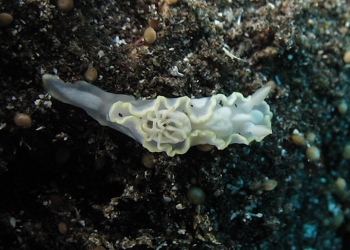
Concerning message #20494:
Dear Bill,
Here is a Glossodoris pallida from Reunion Island, with the classical opaque white markings. A new record from this part of Indian Ocean.
Locality: Pointe au portail, Piton Saint-Leu, 17 metres, Reunion Island, Indian Ocean , 1 september 2007. Length: 15-18 mm. Photographer: Hugues Flodrops.
Best regards.
Hugues.
hugues.flodrops@wanadoo.fr
Flodrops, H., 2007 (Sep 4) Glossodoris pallida from Saint-Leu, Reunion Island. [Message in] Sea Slug Forum. Australian Museum, Sydney. Available from http://www.seaslugforum.net/find/20627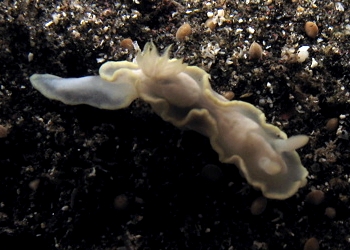
Thanks Hugues,
Bill Rudman
Rudman, W.B., 2007 (Sep 4). Comment on Glossodoris pallida from Saint-Leu, Reunion Island by Hugues Flodrops. [Message in] Sea Slug Forum. Australian Museum, Sydney. Available from http://www.seaslugforum.net/find/20627Re: Glossodoris pallida from Tofo, Mozambique
August 22, 2007
From: Natasja Vandeperre
Concerning message #20494:
Hello Bill,
I find it very hard to estimate the size of the nudi's underwater. I don't like mentioning them if there not very accurate. But I will try in the future. Next holiday I will take a ruler with me.
The sizes of the two specimens I sent you were more or less the same. I think about 2 cm. Maybe you can compare the sizes by comparing my pictures roughly. Except for H. sanguineus I used the maximum zoom and the minimum distance to get the nudi's sharp with my very simple compact camera. And the pictures I send to you are not cropped.
I hope this information can help you a little bit. For my personal feeling these two specimens were not the same species. But I'm afraid this female intuition approach isn't very scientific ;o)
Greetings,
Natasja
postmaster@naaktslakken.be
Vandeperre, N., 2007 (Aug 22) Re: Glossodoris pallida from Tofo, Mozambique. [Message in] Sea Slug Forum. Australian Museum, Sydney. Available from http://www.seaslugforum.net/find/20534Thanks Natasja,
I agree its better to be silent than inaccurate. If you use usually use the same settings on your camera one way would be to photograph your ruler. In that way you would have a scale to measure the nudibranchs on your computer. As I said before I don't need accuracy to 2 decimal places - after all the animals change length as they crawl along, but it is useful to know if I am looking at a 10 mm or 100 mm animal.
And don't knock personal feelings - although you have to finally back them up with some real evidence, in my experience 'gut feelings' often lead to exciting discoveries.
Best wishes,
Bill Rudman
Glossodoris cf. pallida from Tofo, Mozambique
August 21, 2007
From: Natasja Vandeperre
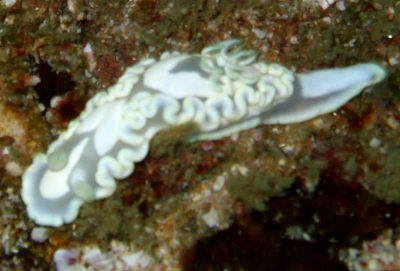
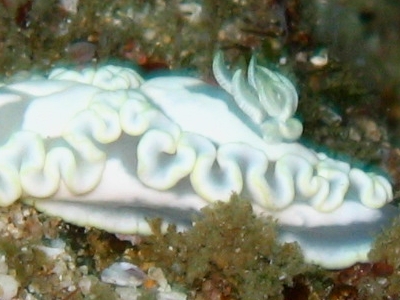
Dear Bill,
This nudi looks just the same as the one in your message of Glossodoris cf. pallida
Locality: Tofo, Mozambique, Indian Ocean, 19 July 2007. Photographer: Natasja Vandeperre.
Greetings,
Natasja
postmaster@naaktslakken.be
Vandeperre, N., 2007 (Aug 21) Glossodoris cf. pallida from Tofo, Mozambique. [Message in] Sea Slug Forum. Australian Museum, Sydney. Available from http://www.seaslugforum.net/find/20497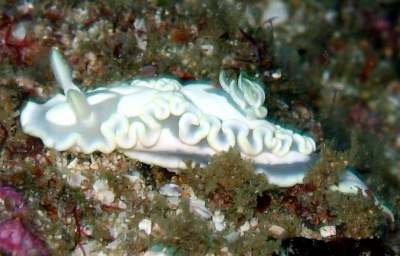
Dear Natasja,
It would be quite valuable if you could include some indication of size in your photos. It does not have to be very precise, but it would be useful to know if we are dealing with a 5 mm long animal or a 5 cm long animal.
I am pretty sure this animal is Glossodoris pallida. The reason I called the one from South Africa Glossodoris cf pallida was because it had no yellow colouration and I thought I should wait until we had a better idea of colour variation before calling it a specimen of G. pallida without yellow colouration. However your animal has yellow so I have no hesitation in considering it G. pallida. If you look at earlier messages about this species you will see that larger specimens often have a much more folded mantle edge - that is why I wondered what size it was. Even being able to compare it with the animal in your earlier message [#20494] would have been useful. Other species, such as G. symmetricus and G. rufomarginata, also have a much more folded mantle edge in larger animals.
Best wishes,
Bill Rudman
Glossodoris pallida from Tofo, Mozambique
August 21, 2007
From: Natasja Vandeperre
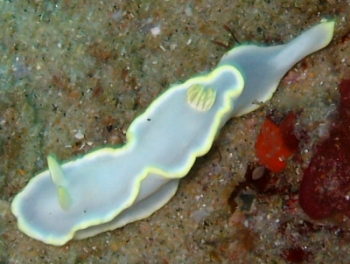
Hello Bill,
Is this Glossodoris pallida? It has a white marking on the foot, but not on the mantle.
Locality: Tofo, Mozambique, Indian Ocean, 17 July 2007. Photographer: Natasja Vandeperre.
Greetings,
Natasja
postmaster@naaktslakken.be
Vandeperre, N., 2007 (Aug 21) Glossodoris pallida from Tofo, Mozambique. [Message in] Sea Slug Forum. Australian Museum, Sydney. Available from http://www.seaslugforum.net/find/20494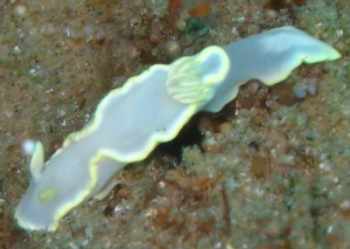
Dear Natasja,
Certainly the white marking on the foot is found in G. pallida, but I would have been happier with some sign of the opaque white markings usually found on the mantle as there are quite a few white species with yellow markings. However I think we are best considering it to be G. pallida.
Best wishes,
Bill Rudman
Glossodoris pallida from the Philippines
August 9, 2006
From: Carlos R. Munda
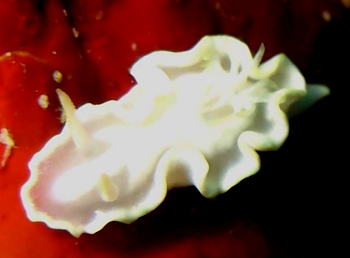
Here is a Glossodoris from the Philippines
Locality: Samal island, 50-60 feet, Philippines, Pacific, 24 July 2006, reef wall. Length: 3/4 inch. Photographer: Carlos R. Munda, jr..
Carlos R. Munda
c_munda@yahoo.com
Munda, C. R., 2006 (Aug 9) Glossodoris pallida from the Philippines. [Message in] Sea Slug Forum. Australian Museum, Sydney. Available from http://www.seaslugforum.net/find/17238Dear Carlos,
This is Glossodoris pallida
Best wishes,
Bill Rudman
Glossodoris pallida retracting its rhinopores
April 12, 2006
From: Colin Ogden
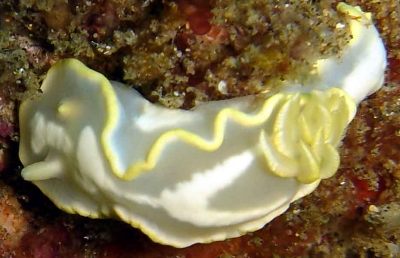
Hi Bill,
In a previous message [#14635] on Hypselodoris carnea, you gave me a great explanation on the animal retracting its gills. Here I have a Glossodoris pallida which at first I thought was missing one of its rhinopores, but within seconds it had extended the "deformed" rhinopore. I, from your message mentioned above knew that this was possible with the gills of some species, but obviously they can also do this with their rhinopores.
Locality: Sodwana Bay, 12 metres, South Africa, Indian, 08 April 2006, Coral reef. Length: 20mm. Photographer: Colin Ogden.
Thanks as always
Colin
scubaco@iafrica.com
Ogden C. M., 2006 (Apr 12) Glossodoris pallida retracting its rhinopores. [Message in] Sea Slug Forum. Australian Museum, Sydney. Available from http://www.seaslugforum.net/find/16288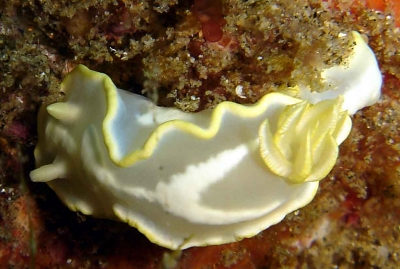
Dear Colin,
Yes the dorids that have apocket into which they can retract their also have a pocket for each of their rhinophores. Since they are precious sense organs, it's useful to be able to hide them like rhis from nibbling dish, and also from excessive amounts of silt that could clog up the leaflets or lamellae that many rhinophores possess.
Best wishes,
Bill Rudman
Glossodoris pallida from the Solomon Ids
April 19, 2005
From: Bruce Potter
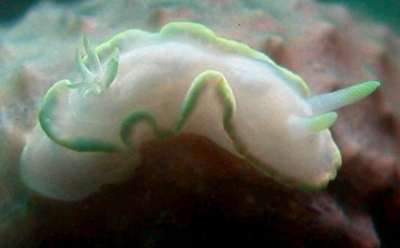
Dear Bill,
I have recently departed from Solomon Islands after 15 years there. I will send a few of my last finds to you.
The first is this Glossodoris pallida. It was very tiny at about 5mm long. It was on a dark sponge at about 12 meters on a coral and rubble site just on the outskirts of Honiara.
Locality: Honiara, Solomon Islands, Pacific Ocean. Depth: 12 meters. Length: 5 mm. 5 January 2005. Coral, Rubble and Sand. Photographer: Bruce Potter
Regards
Bruce
bandppotter@bigpond.com.au
Potter, B., 2005 (Apr 19) Glossodoris pallida from the Solomon Ids. [Message in] Sea Slug Forum. Australian Museum, Sydney. Available from http://www.seaslugforum.net/find/13524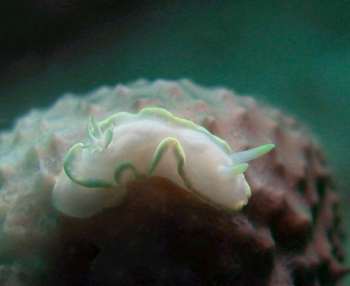
Dear Bruce,
I hope the culture shock in returning to Australia after 15 years is not too great. I am interested in your mention of a 'dark sponge'. Are you referring to the sponge in your photo or another one?
Best wishes,
Bill Rudman
Glossodoris pallida from Great Barrier Reef
December 6, 2003
From: Paul Osmond
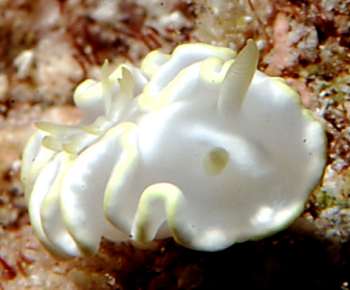
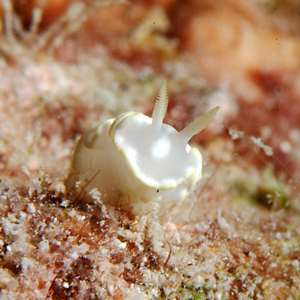
Hi Bill,
Another nudibranch from the Great Barrier Reef off of Townsville [Queensland, Australia] - this one I believe is Ardeadoris egretta although the yellow tipped rhinophores may say something different.
Thanks,
Paul
www.deepseaimages.com
marriard@deepseaimages.com
Osmond, P., 2003 (Dec 6) Glossodoris pallida from Great Barrier Reef. [Message in] Sea Slug Forum. Australian Museum, Sydney. Available from http://www.seaslugforum.net/find/11620Dear Paul,
There are a group of yellow bordered white species so you were right to hesitate when the rhinophore colours looked wrong. This is Glossodoris pallida, which as you will see from other photos on the page is characterised by the pattern of opaque white markings down the midline of the mantle.
Best wishes
Bll Rudman
Glossodoris pallida from South Korea
May 2, 2003
From: Dong Bum, Koh
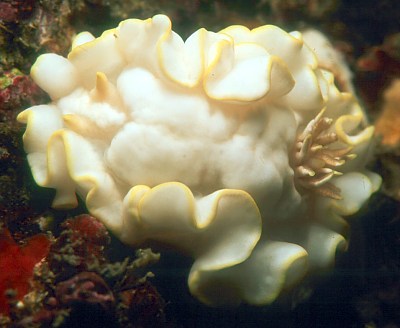
Dear Bill,
Here is a photo of what I think is Glossodoris pallida taken near Bum islet(about 2km west direction far from Moon islet) in Jeju, Sth Korea.
But I'm not sure about my identification.
Depth: 18m
Date: 13 April 2003
W/T: 15 degrees
Photo: Dong Bum,Koh
Best regards,
Dong Bum, Koh
drkoh@seasee.co.kr
Koh, D.B., 2003 (May 2) Glossodoris pallida from South Korea. [Message in] Sea Slug Forum. Australian Museum, Sydney. Available from http://www.seaslugforum.net/find/9672Dear Dong Bum,
This looks to be quite a large animal, with quite a folded edge to the mantle. There are a number of similarly coloured species but the opaque white pattern on the mantle is quite characteristic of this species. I can see part of the elongate path between the rhinophores and the 'heart'-shaped pattern just behind that, so I am pretty sure your indentification is correct.
Best wishes,
Bill Rudman
Glossodoris pallida from SE Sulawesi, Indonesia
September 23, 2002
From: Lindsay Warren
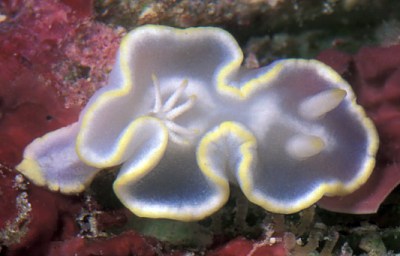
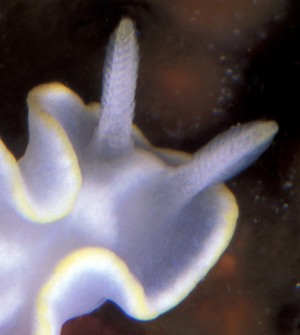
Dear Bill,
Please find attached a couple of shots of Glossodoris pallida (OS01075) which I found on 11 October 2000 sauntering along on some coralline algae and rubble at the reef crest on Pulau Hoga, Tukang Besi Archipelago, SE Sulawesi, Indonesia. Depth: 15ft; Specimen length: 9mm. As you can see, even in this small specimen the white patches on the notum are quite clear. This specimen is lodged with the Museum Zoologicum Bogoriense, Cibinong, Java reg no: MZB.Gst.11.913.
As you mentioned elsewhere on the Sea Slug Forum a look at the radula may be the only way to solve the 'problems' between these and the unmarked ones.
All the best
Lindsay
alldcl@compuserve.com
Warren, L., 2002 (Sep 23) Glossodoris pallida from SE Sulawesi, Indonesia. [Message in] Sea Slug Forum. Australian Museum, Sydney. Available from http://www.seaslugforum.net/find/7978Thanks Lindsay,
Bill Rudman
Glossodoris pallida from Papua New Guinea
October 28, 2001
From: Marli Wakeling
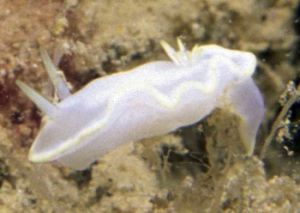
Hi Bill,
Here is the last from my summer journey! This tiny critter looks like Glossodoris pallida. This was on a much covered wreck of a Japanese mini submarine, near New Hanover, Papua New Guinea.
Dive Site: Wreck of the Taisho Maru, New Hanover, Papua New Guinea
Date: July 24, 2001
Depth: 22 meters
Length: 7mm
Photograph: Marli Wakeling
Marli
scubamarli@excite.com
Wakeling, M., 2001 (Oct 28) Glossodoris pallida from Papua New Guinea. [Message in] Sea Slug Forum. Australian Museum, Sydney. Available from http://www.seaslugforum.net/find/5535Thanks Marli,
I've got your messages out of order so although this might have been the last you sent from you summer holidays, there are still a few to appear on the Forum. It is interesting to compare the colour of your animal with that in the photo Nishina recently sent of one from Japan, in which the yellow was a dull cream colour and the white mark on the back was invisible.
Best wishes,
Bill Rudman
Ardeadoris? from Hachijo Island Japan
October 27, 2001
From: Nishina Masayoshi
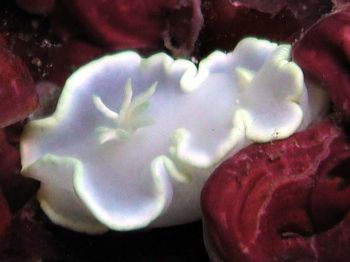
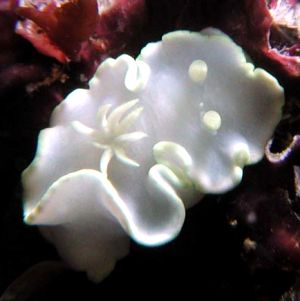
Dear Dr.Rudman,
I thought that this animal was a juvenile of the Glossodoris pallida, but now I wonder if it is instead a juvenile of Ardeadoris egretta. It does not have the characteristic pattern which G. pallida has on the surface of that animal's body. But, the gills don't seem right for A. egretta. Perhaps it is for example something else, perhaps a kind of Noumea?
Data:
Date: 21 Oct, 2001
Location: Hachijo Island Japan
Depth: 6m
Length: 10mm
Best Regards,
Nishina Masayoshi
nishina@wips.co.jp
Nishina, M., 2001 (Oct 27) Ardeadoris? from Hachijo Island Japan. [Message in] Sea Slug Forum. Australian Museum, Sydney. Available from http://www.seaslugforum.net/find/5546Dear Nishina,
There are quite a few species which are white with yellowish markings so you are right to be cautious in identifying them. Despite the lack of the characteristic white markings on the back I think this is a juvenile Glossodoris pallida. Sometimes the marking is not that obvious in living animals, and in other cases, animals with very visible markings in life seem to have completely lost them in photos.
There is always the possibility though that it is something different. Only a look at its radula would resolve that doubt.
best wishes,
Bill Rudman
Glossodoris pallida from Hachijo Is, Japan
August 17, 2001
From: Nishina Masayoshi
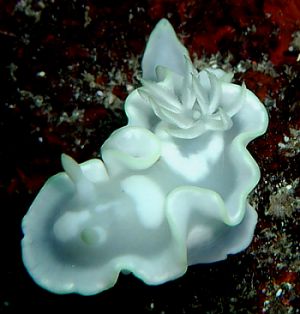
Glossodoris pallida is common at Hachijo and Sagami Bay.
Date: 29 June, 2001
Place: Sokodo, Hachijo Island, Japan
Depth: 10m
Size: 30mm
Photos by Nishina Masayoshi
Best Regards,
Nishina Masayoshi
nishina@hpe15.wips.co.jp
Nishina, M., 2001 (Aug 17) Glossodoris pallida from Hachijo Is, Japan. [Message in] Sea Slug Forum. Australian Museum, Sydney. Available from http://www.seaslugforum.net/find/4979Thanks Nishina,
Bill Rudman.
Glossodoris pallida from American Samoa
July 23, 2001
From: Don Barclay
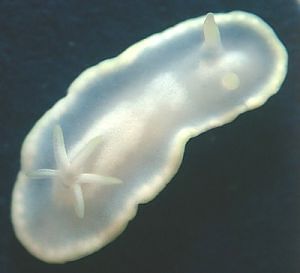
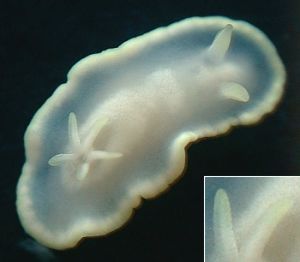
Dear Bill,
Larry Madrigal and I went diving last Sunday morning on the northwest side of Tutuila, in the same area where we found the brown Dendrodoris nigra last year, as well as the Chelidonura pallida and the Glossodoris atromarginata with the "African" coloration. This is the only unusual one we found there this time, and appears to be either a juvenile Glossodoris pallida or maybe the same as the "Glossodoris cf. pallida" on the Forum, if they are different species. Looking at the slug through magnification, I can't really see any yellow on the animal, but as you will see in the photos, there seems to be a trace of very pale yellow on the rhinophores, gills, and parts of the mantle edge. I took a lot of photos, thinking it was the shadows or flash making only parts of the mantle edge look pale yellow, but I finally decided that's how it actually is. I guess it's closer to being just a cream or yellowish tint to the white than actually being yellow, so maybe it is the same as Valda's. Or maybe small juveniles of G. pallida don't get the yellow markings until later?
Larry collected this one about 1100 local time on 15 July 2001, under a slab in 15m of water, three coves east of Fagamalo village, northwest Tutuila Island, American Samoa. It was tiny, only measuring about 7mm outstretched.
This one waved its gills around when it was crawling, very unlike the "vibrating" done by the little white Noumea I submitted recently. Neither Larry nor I have found this species before. Do you think it's G. pallida?
Many thanks,
Don
n5ols@samoatelco.com
Barclay, D., 2001 (Jul 23) Glossodoris pallida from American Samoa. [Message in] Sea Slug Forum. Australian Museum, Sydney. Available from http://www.seaslugforum.net/find/4883Dear Don,
This is definitely G. pallida. There is definitley a hint of yellow on the gills and around the mantle edge. At 7mm it is a wonder there is any colour showing. Most juveniles start off as translucent clear or white and only get their adult colouration as they grow. Sometimes it is not really possible to identify them unitl they reach a certain size. In this case the shape the opaque white markings on the mantle and the tinge of yellow leave little doubt that this is G. pallida. Concerning 'gill wiggling' - it definitely comes in different styles. [Note: the link to your white Noumea won't work as yes because I haven't posted that message]. In many smaller species of Noumea and Thorunna the wiggling is a very fast rhythmic display, while in many species of Glossodoris it seems to be a more relaxed, though quite regular, 'wave'.
Best wishes,
Bill Rudman
Glossodoris pallida from Vanuatu
December 6, 1999
From: Vinka Stenhouse
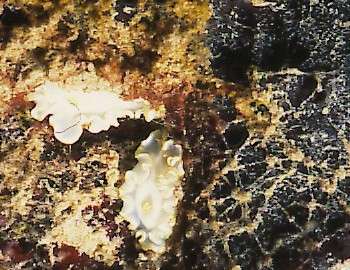
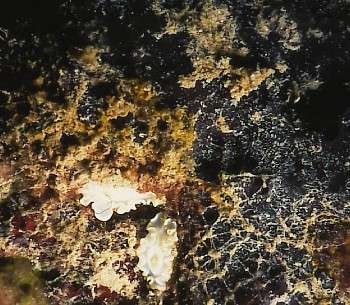
Dear Bill,
This one is from, Espiritu Santo Is., Vanuatu. 1995. It was 2cm long. Found at 10 metres on a bommie ledge. PHOTO: J.K. Stenhouse
Yours sincerely,
Vinka Stenhouse.
Santo.
Vanuatu.
Dear Vinka,
This is Glossodoris pallida. The photo is quite interesting because it shows the animals on a large colony of a grey-black sponge which is almost certainly their food. It looks the same as described recently by Avila & Paul (1997) as a dictyoceratid sponge Cacospongia sp.. Their paper is very interesting because it contains good evidence to show that chromodorids are storing antifeedant chemicals, which are derived from their food, in particular parts of their body. They also showed that these chemicals do indeed deter fish.
In brief they found sponge-derived terpenoid compounds concentrated around the mantle border and in the mucous secretions of the mantle. They found that at their natural concentrations these chemicals deterred some crabs and reef fishes from feeding. They also found that animals which had had their mantle borders removed were much more likely to be eaten than those in which the mantle was intact. This is a very significant advance in our understanding of the biology of these fascinating animals. See also the page on chemical defence in nudibranchs.
Best wishes,
Bill Rudman.
Reference:
•Avila, C. & Paul, V.J. (1997) Chemical ecology of the nudibranch Glossodoris pallida: is the location of diet-derived metabolites important for defense?. Marine Ecology Progress Series, 150: 171-180.
Glossodoris pallida from Philippines
November 15, 1999
From: Erwin Koehler
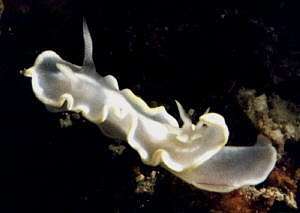
Dear Bill,
Here is Glossodoris pallida (Rüppell & Leuckart, 1831), BBC, Panglao Is., Philippines, Nov. 1998.
Medslugs.Koehler@t-online.de
Koehler, E., 1999 (Nov 15) Glossodoris pallida from Philippines. [Message in] Sea Slug Forum. Australian Museum, Sydney. Available from http://www.seaslugforum.net/find/1476